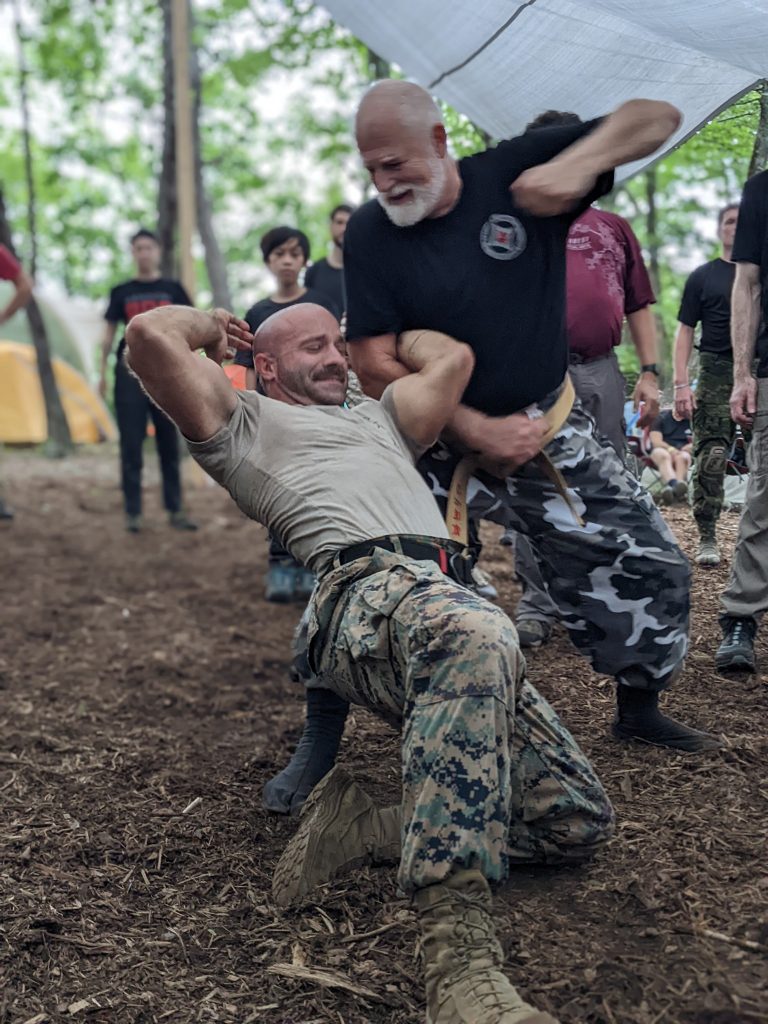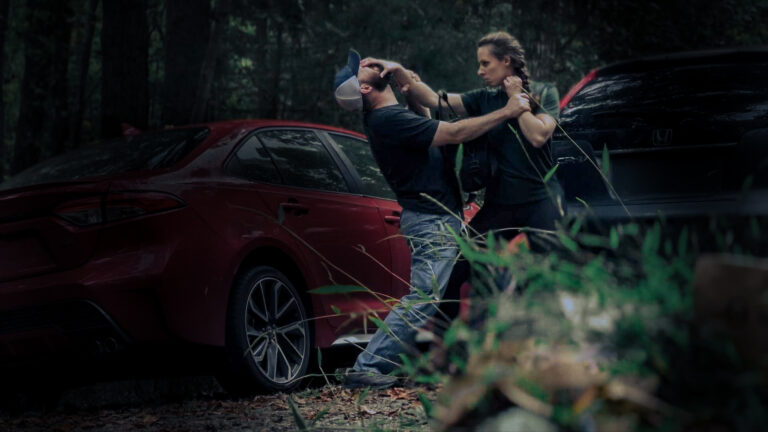
MARTIAL schools build your body and teach you how to win contest fights in a sporting arena.
Hit harder. Kick higher. You want to feel powerful, but mostly you’re feeling knee pain.
ART schools sharpen your mind with traditional forms.
You feel focused and confident performing your sword kata in the dojo, but are still pretty nervous walking through a parking lot at night.

We offer the best of both worlds.

Century after century the legendary samurai and ninja of Japan refined their skill in combat, adapting their techniques as new challenges and opportunities emerged.
Our martial art, To-Shin Do, keeps their legacy alive by continuously adapting the battle-tested training of the past to effectively meet the physical, mental, and spiritual challenges of today.
(Our dojo’s senior instructor, Bryan, is battle-tested as well—a veteran Marine Corps scout sniper with plenty of stories to tell from his combat experience in Iraq and Afghanistan).

What makes a self-defense system
intelligent?
Some martial arts schools add a short self-defense curriculum into their competition-based or form-based art.
They may offer occasional weekend workshops on self-defense.


But just because a wrist grab defense can be explained in an hour, doesn’t mean it can be learned in an hour.
Knowing a few moves isn’t the same as being ready for the chaos of real violence.
In our training
your "what ifs" matter
"what ifs" matter
What if the attacker is drunk and not feeling pain? What if they have a weapon? What if there’s more than one of them?
What if they’re twice my size? What if they grab my bad shoulder? What if fighting back causes them to escalate?
What if my move is a throat punch or eye gouge, but my attacker hasn’t attacked yet, they’re just talking, testing my boundaries?
What if I don’t want to hurt my attacker—it’s a family member or a kid having a mental breakdown? What if I have to go to court to defend how I defended myself?
What if my move is to be hyper-vigilant and suspicious…
The ability to operate masterfully under pressure in complex, unexpected situations takes years of training—especially if you’re a busy person who only trains a few hours a week.
Beginners in our martial art study techniques that are most likely to work for beginners (shin to the groin, fingers to the eyes, making a lot of noise), while building the foundational skills needed to expand their capabilities.


Yes, we’ll show you how it works if they have a weapon. We’ll show you how it works if they don’t respond to pain. We’ll show you how to restrain someone without damaging them. We’ll show you how it works if they’re bigger and stronger than you!
Instead of hearing, “We don’t have time to cover all of these what ifs!” You’ll hear: “That’s a great question—I can show you what that looks like now, and we’ll start working on that in your Level 3 training.”
As a former practitioner of jiu-jutsu, judo, and hapkido, I have finally found what I’ve been searching for. To-Shin Do has taught me key fundamental principles that are at the heart of all martial art styles. I really enjoy practicing with the historical Japanese weapons too! It’s something I’ve always wanted to learn, but I found that most martial art schools specialize in one thing or another. At Quest we get to practice it all – ground, grappling, throws, strikes, weapons, and more.
The instructors are phenomenal. They understand the techniques down to the finest detail and teach with a sense of humor that connects with everyone. All four of my children enjoy training here as much as I do!

Ian Lopez
To-Shin Do student, US Naval Officer
There’s no “one-size fits all” solution to most problems. But when we know more about a problem, we’re more able we can pick the right solution.
Our Martial Art uses a five element model to give you options.
This five element cycle exists naturally in the world. We can see it in both mechanical physics and human emotional responses.


These elements were cleverly hidden in the scrolls of old martial arts. An-shu Stephen Hayes discovered that their significance had largely been lost to time.
In mountain temples, he studied extensively and came to fully uncover their importance for achieving balance and power of the mind and body.
His research resulted in a self-defense martial art that offers a complete understanding of the impact of our emotions when under mental, verbal, or physical attack.
The Five Elements of
To-Shin Do
WHITE & YELLOW BELT
Earth Element
Command • Abundance
Remain grounded in your thinking and footing to repel attempts to distract or deceive you. Stay stable against attacker’s push and pull. Be hard to take off balance.
Learn to use your entire body with each movement to deliver full power.
Confident • Stable • Grounded
BLUE BELT
Water Element
Resourcefulness • Science
Shift, angle, and move fluidly to confuse attackers and put them off balance.
Learn to control the distance between you and an aggressor. Use correct angles and contact to gather information and create openings in their defense.
Strategic • Analytical • Technical
RED BELT
Fire Element
Artistry • Connection
See where a situation is going as it develops and intercept it at the critical moment.
Learn to control the timing of a conflict. Develop an awareness of the attacker’s next move, and cut him off before he has a chance to build momentum.
Pro-Active • Ready • Engaged
GREEN BELT
Wind Element
Freedom • Service
Stay light on your feet and move nimbly to evade attempts to pin you down. Explore when to stand firm and when to relax and go with the flow of a fight.
Learn to easily slip past an attack to trap and entangle the aggressor.
Mobile • Unencumbered • Evasive
BROWN BELT
Void Element
Formless Potential • Creativity
Combine movements from the four base element principles.
Confuse your attacker by shifting elements. Make him believe that he is winning, so he remains committed to his attack, until it’s too late for him to adjust to your defense.
Creative • Big-Picture • Formless
BLACK BELT
Advanced Elements
Effortless • Invisible
Work towards mastery of all elements, weaving them together to create an art unique to your mind, body, and spirit.
Continuous refinement of your skills and senses allows for instinctive, effortless, even invisible success. What just happened?
Unique • Personalized • Masterful
Students will spend about one year of training in each element before moving to the next.
Therefore, one can expect to earn a first degree black belt in To-Shin Do in roughly 5 years, with consistent training of 2-3 times per week.
How do we effectively simulate
real violence?
We start with careful cooperation—
We start with careful cooperation—
In a competition both participants want the same thing: to win.
In a self-defense situation, attackers have a variety of goals. To intimidate you. To hurt you. To take you somewhere. As a defender you might have to stand your ground, restrain someone, or run for it!
In To-Shin Do, students take turns being the attacker and the defender in a variety of scenarios. But the goal is not to see who wins! The attacker’s goal is to increase the skill of the defender by providing the appropriate amount of speed, force, intensity, and encouragement.

—until you're ready for chaos!

—until you're ready for chaos!
As students progress in their ability to defend themselves in a variety of scenarios…we drop the scenarios.
In a practice called randori, a student defends against random incoming attacks from one or more attackers. It’s the ultimate exercise of creativity and quick-thinking!
In randori, typically, no sparring gear is worn and no targets or strikes are off-limits. Attackers can use their words or pull out weapons. Safety is maintained by, once again, skillfully matching the speed, force, and intensity to the defender’s ability.
A life-saving skill.

A life-saving skill.
Most of us are more likely to be injured tripping over our own feet or falling off a bicycle than in a back-alley knife fight.
Being able to get to the ground safely (in whatever way works for your body) can save your life and protect you from injury as you age.
Mobility matters.
In real world self-defense, you almost never want to go to the ground and start grappling.
You don’t want to sacrifice situational awareness and mobility. You don’t want to find out too late that your attacker wasn’t alone.
But real world self-defense means being ready for anything. You might have to go to the ground! It’s important to know how to roll with it or roll out of it!

The Art of Ukemi.

In training, if the defender is meant to take your balance or send you to the ground with a joint lock or strike—you need to know how to go to the ground! Otherwise, you’ll subconsciously resist providing realistic momentum and force for your training partner, in an attempt to avoid what you know is coming.
In many Japanese martial arts the “attacker” is actually given the name uke, which means “receiver.” Your ability to attack is directly related to your ability to receive!
AGES 8 - ADULT
To-Shin Do










We fit a lot into our 45-minute To-Shin Do classes! Classes are broken down into 4 different levels, based on training experience. We begin by warming up with some mobility, balance, and conditioning exercises.
Our curriculum rotates monthly, with a few self-defense scenarios in each level. We will practice the techniques with a partner, explore a couple variations or answer questions. While working with partners, we begin slowly, and gradually increase speed. The focus is on proper positioning and timing while working with our friends.
We will then grab targets and practice the striking component of the technique against a pad. This is where we practice at real fight speed and power to gain a complete knowledge of a fighting principle while ensuring everyone stays safe throughout the training.
Once the class has a solid grasp of a technique, we will practice using the same strategy in different situations. Can I do this defense on the ground? What if I am backed up against a wall? What if the attacker has a weapon? What if I’m facing multiple opponents? Can I do this defense with one arm because I’m using the other to keep my kids behind me? What if someone hasn’t actually “attacked” me but I feel like they are stepping over the line and testing my boundaries? What words might I use to make it clear that I do not want to fight, but I am prepared to defend myself? What are the before a fight signals I should become aware of, and what are the after a fight considerations I should take to ensure my continued safety?
In this way, a student becomes deeply familiar with the root principle of a technique, and develops an ability to think freely and adapt their self-defense response to many different possible situations or environments.
It’s so much more than simply “learning a few moves.”
AGES 4 - 7
Mighty Dragons








In our 30 minute classes, kids work on their balance, timing, and coordination with animal walks, obstacle courses, ninja rolls, and rubber throwing star practice. They also work on target striking and age-appropriate self-defense techniques—including the most important self-defense skill for kids, the ability to speak up! Classes often end with high-energy, quick-thinking games like padded sword battles.
The biggest difference between Mighty Dragons and our classes for older kids and adults is that Mighty Dragons do not practice self-defense techniques on each other. They practice exclusively with instructors and helpers (which we call coaches).
These classes are developmentally appropriate for children. They touch on fundamental self-defense skills, like being able to say no to something that isn’t safe, but the training at this age is meant to be more fun than scary.
Mighty Dragons class teaches children how to learn martial arts. Typically, once a child is 8 years old, they are ready to move up to our To-Shin Do program, where the training gets a bit more serious.
As Mighty Dragons, kids enjoy lots of praise and positive reinforcement, helping them develop a strong sense of self-confidence that will accelerate their success in all their future endeavors.
Parents are often impressed when they see that their child wants to show just how focused they can be. Mighty Dragons will have the opportunity to earn stripes and belts as they progress in their training. We often remind the kids that they earn their promotion by demonstrating the 3 keys of success, that they recite at the beginning of each class in the dojo’s Student Creed:
Confidence – Did you try your best and train with effort?
Discipline – Did you focus and use your time well?
Respect – Were you helpful and kind to those around you?
If they can answer yes to all these questions, they earn their stripe. If they do not earn a stripe, the child can always tell us which of the 3 keys they need to work on next class to advance.
It’s about giving them responsibility, ownership, and opportunity to show that we trust them to accomplish their goals.
Historically, children born in a ninja village would begin training at a young age. But their training would be disguised as games to improve their physical skills and mental concentration. We take the same approach today.
Our Mighty Dragons think they’re just playing games, but the parents completely understand all the valuable lifelong lessons their children are learning on the mat.
Sensei Bryan helped one of our Mighty Dragons show her kindergarten class what we do at the dojo!
Why does a self-defense system
wear uniforms?

It’s a great idea to spend time training in different clothes and shoes as well as in different environments—in the woods, on concrete, in hallways, or between cars. We create opportunities throughout the year for these sorts of experiences.
But, when it comes down to it, training is hard on clothes and on bodies. Wearing uniforms and training on mats protects your favorite shirt and your only body from wear and tear.
traditional + functional

Furthermore, traditional rituals, like wearing a uniform, bowing, or reciting our student creed serve students in multiple ways:
• It creates a specific context for training, which can enhance memory and focus—a phenomena called context-dependent learning.
• It becomes a habit cue that can help us show up for training—like putting your running shoes by the bed the night before a morning run.
• It connects us to the history and culture from which our practice originates. Connecting in this way is respectful, interesting, and provides context that can be critical to understanding the why behind many of our methods.
• Brightly-colored belts that symbolize rank were not used prior to the 20th century, but our belts serve a purpose as well—each color of belt we don signifies a commitment to a specific elemental approach.
This training builds you. It lets you be in the body you’re in with the life you’ve lived and then find and expand the strength in who you are.
Adding to that, my kids watch me be a learner, deal with struggle, and find my power. And I witness them do the same. I want them to see me and other parents doing the cool thing, not just watching and waiting for our turn. They’re learning that at any age, you don’t have to put your own growth on hold, you can do it now!
I know they’ll take these lessons into the world every day, long after we’re in the dojo together.

Emily Malpass
To-Shin Do practitioner, Art teacher

Life doesn’t wait until you’re ready. Violence will be glad you gave into the excuses and put off training until you felt “up for it.”
Chances are, if you need to defend yourself or protect others, you won’t have time to warm up. You won’t have the right shoes on. That old knee will feel stiff. You won’t be perfectly rested.
And you’ll have to do it anyway.
You don't have to get ready
to get on the mat.

You can start now. You can start with what you’ve got.
Because our martial art is not performative or confined to the rules of a sport, we have the freedom to modify, customize, and adapt the techniques to you.
If your shoulder doesn’t move the way it used to, that’s ok. We’ll work together and discover the best way for you to practice the technique.
To-Shin Do doesn’t produce rows of robots who all look and move the same. We help individuals find the strength in who they are and celebrate the unique distinctions that each person brings to our shared training experience.
Like any other art, at first you’ll learn by copying those with more experience. But the eventual goal is to create a signature style that is unique to your body and your life—a style that continues to evolve as your life changes and your skills increase!


